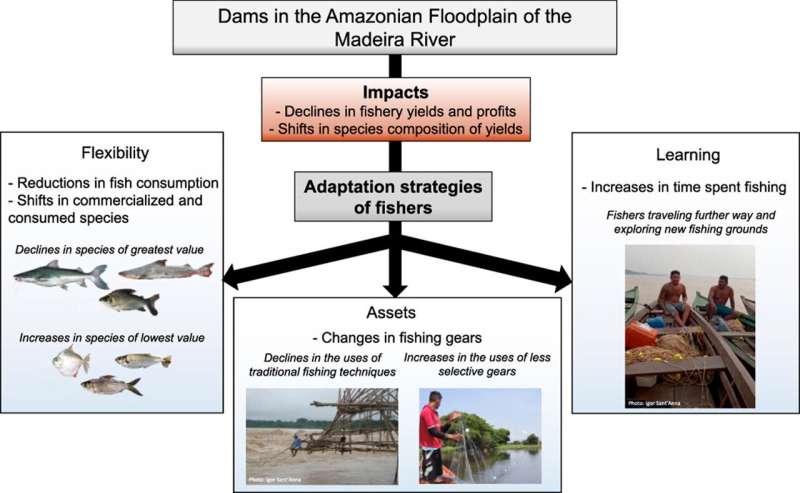This article has been reviewed according to Science X's editorial process and policies. Editors have highlighted the following attributes while ensuring the content's credibility:
fact-checked
peer-reviewed publication
trusted source
proofread
Researcher studies effects of Amazon mega dams on biodiversity and local communities

One West Virginia University researcher is working to protect the communities and economies often affected when companies move in to harness a region's natural resources.
Appalachia has a long history of dealing with negative consequences, and the Brazilian Amazon is at risk of experiencing the same which is where Caroline Arantes, assistant professor of wildlife and fisheries resources in the WVU Davis College of Agriculture, Natural Resources and Design, has focused her research.
Concern for the Amazon is often centered around its biodiversity, but Arantes' focus is not only on diverse aquatic faunas, but also on the human communities affected and often displaced by the development of hydropower dams—specifically, the Madeira River dam.
"Many people depend on water systems and resources to support their livelihoods," Arantes said. "We wanted to understand the effects and learn how people adapted to the changes."
Arantes and her fellow researchers surveyed families living, or that once lived, in communities at the edge of the river. When the dams were built, some families were told to leave the location because the area would be flooded. They were relocated to a resettlement more than 50 miles away from their homes and the river.
"You can imagine how their lives changed, including their financial and food security," Arantes said. "Before construction, their boats were already in the water ready to use. Now, being far away from the river costs them time and financial resources, increasing expenses with fisheries activities and impacting their food systems and fishing profits."
After resettlement, travel time replaced productive fishing time. Because of this, some people abandoned the trade entirely to work on a farm, run a small business or hold down temporary jobs.
For those who continued to fish, business wasn't business as usual. Arantes and her collaborators found fishery production declined by 37% after dam construction, leading to reduced profits and income.
"The research team also discovered a change in the species composition yields," Arantes explained. "Large fish species are of greater economic importance and they were replaced by smaller fish of less economic importance. That has affected the monetary value of the fisheries, making it less financially feasible for fishermen to make a profitable living."
She and her team also uncovered the demonstrated resilience and adaptability of Amazonians.
Those who continued to fish changed the types of gears they used, discontinuing traditional fishing in favor of less selective gears that target a wide range of species. In addition, the research team found the main types of fish consumed by families changed and quantities generally declined. Some of these seemingly helpful adaptations may cause new problems in the future with human nutrition and food security.
"Fish is a really important food resource for riverine communities," Arantes said. "Because of a reduction in fish consumption in the weekly diet, the void might be replaced with other types of food which could ultimately affect nutrient intake levels. Having less fish could also affect food security if there is nothing to replace it with. We don't really know yet."
The Madeira River communities are one example in a long list of places and peoples that have been overlooked in the gambit for profit via an area's intrinsic attributes. Deforestation in 1880 left West Virginia denuded, negatively impacting ecosystems for decades.
Arantes' research may be able to prevent similar situations from occurring elsewhere. She said her hope is that her results will be used to inform future mitigation and compensation processes surrounding hydropower dam construction. Socioeconomic impacts and necessary adaptation strategies—which can be costly—should be considered and accounted for in those processes, she said.
"The price they pay for energy and electricity in the resettlement is greater than what they paid before," she said. "That demonstrates why it's important for companies and the governments responsible for licensing to consider the types and magnitude of impacts, and to provide appropriate compensation measures and adaptation assistance."
Future research opportunities may include focusing on alternative sources of renewable energy like solar power and in-stream turbines. Using other energy sources could minimize the need for large dam projects that disrupt the lives of people and still provide local communities with sustainable energy.
Additionally, monitoring fishery systems is necessary to understand the magnitude of socioeconomic and ecological impacts caused by mega dams. Arantes and her team, including graduate student Sam Grinstead, are developing ecological assessments of long-term responses of fish communities to dams and associated changes in river conditions.
The research was published in the Journal of Applied Ecology and the Journal of Environmental Management.
More information: Caroline C. Arantes et al, Functional responses of fisheries to hydropower dams in the Amazonian Floodplain of the Madeira River, Journal of Applied Ecology (2021). DOI: 10.1111/1365-2664.14082
Caroline C. Arantes et al, Large-scale hydropower impacts and adaptation strategies on rural communities in the Amazonian floodplain of the Madeira River, Journal of Environmental Management (2023). DOI: 10.1016/j.jenvman.2023.117240
Journal information: Journal of Environmental Management , Journal of Applied Ecology
Provided by West Virginia University





















